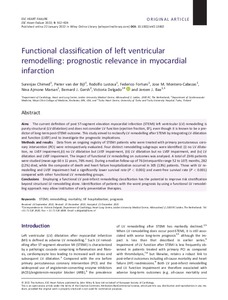Functional classification of left ventricular remodelling: prognostic relevance in myocardial infarction
Bax Jeroen J.; Lustosa Rodolfo; Gersh Bernard J.; Delgado Victoria; Chimed Surenjav; Fortuni Federico; van der Bijl Pieter; Montero-Cabezas Jose M.; Marsan Nina Ajmone
https://urn.fi/URN:NBN:fi-fe2022081154260
Tiivistelmä
Aims The current definition of post ST-segment elevation myocardial infarction (STEMI) left ventricular (LV) remodelling is purely structural (LV dilatation) and does not consider LV function (ejection fraction, EF), even though it is known to be a predictor of long-term post-STEMI outcome. This study aimed to reclassify LV remodelling after STEMI by integrating LV dilatation and function (LVEF) and to investigate the prognostic implications.
Methods and results Data from an ongoing registry of STEMI patients who were treated with primary percutaneous coronary intervention (PCI) were retrospectively evaluated. Four distinct remodelling subgroups were identified: (i) no LV dilatation, no LVEF impairment,(ii) no LV dilatation but LVEF impairment, (iii) LV dilatation but no LVEF impairment, and (iv) LV dilatation and LVEF impairment. The impact of functional LV remodelling on outcomes was analysed. A total of 2346 patients were studied (mean age 60 +/- 11 years, 76% men). During a median follow-up of 76 (interquartile range 52 to 107) months, 282 (12%) died, while the composite of death and heart failure hospitalization occurred in 305 (13%) patients. Those with LV remodelling and LVEF impairment had a significantly lower survival rate (P < 0.001) and event-free survival rate (P < 0.001) compared with other functional LV remodelling groups.
Conclusions Employing a functional LV post-infarct remodelling classification has the potential to improve risk stratification beyond structural LV remodelling alone. Identification of patients with the worst prognosis by using a functional LV remodelling approach may allow institution of early preventative therapies.
Kokoelmat
- Rinnakkaistallenteet [19207]
